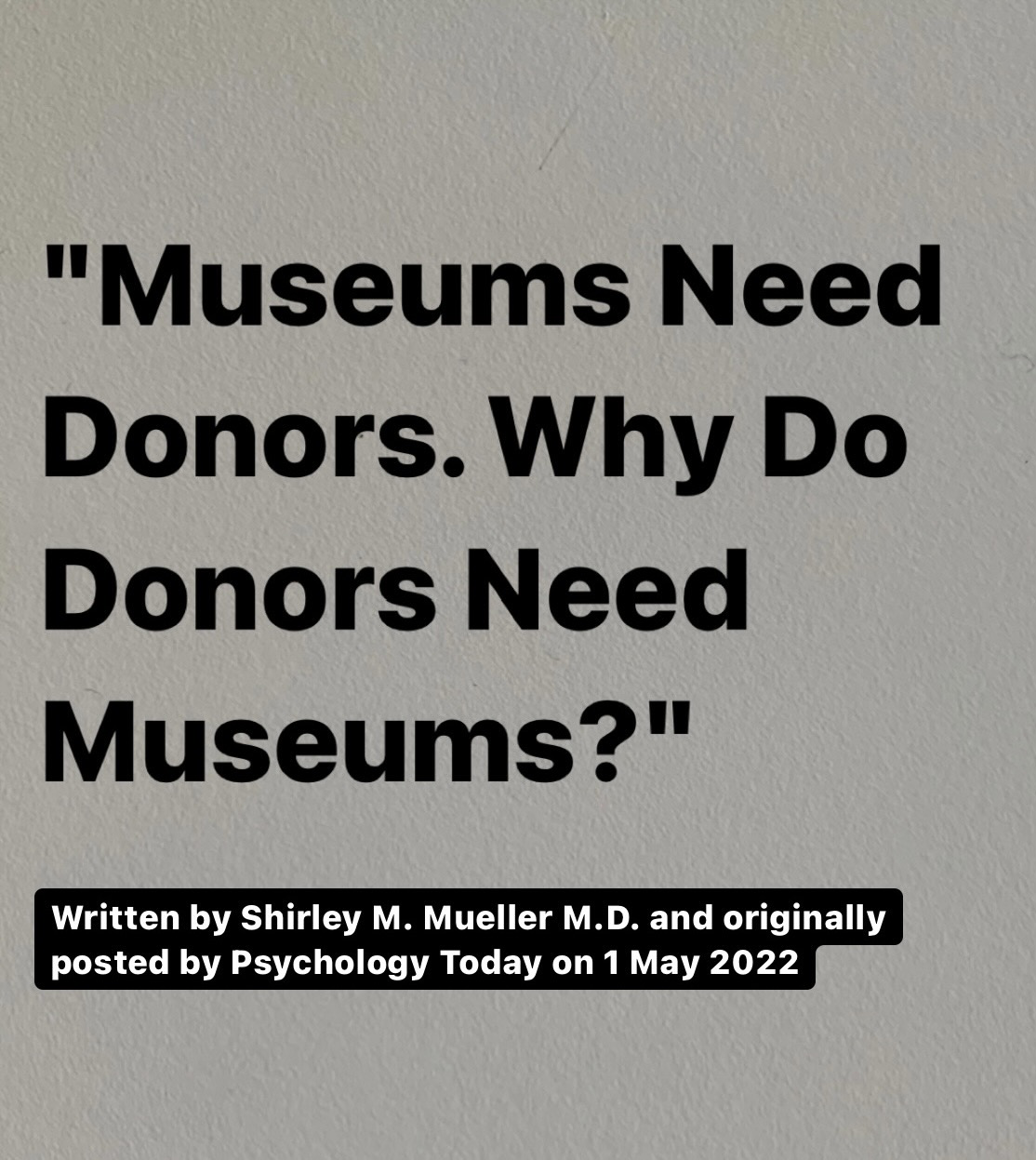Museums Need Donors. Why Do Donors Need Museums?

Written by Shirley M. Mueller M.D. and originally posted by Psychology Today, 1 May 2022.
KEY POINTS
- When a museum leaves a mark on the visitor, the visitor sometimes wants to leave a mark on the museum by becoming a donor.
- Donors are additionally motivated to give to museums due to a sense of responsibility to preserve the past.
- Offerings to museums from donors should be thought of as indicators of a healthy community relationship, whether accepted or not.
In my book, Inside the Head of a Collector: Psychological Forces at Play, I quote Thomas Campbell, then Director of the Metropolitan Museum of Art (2009), “The Met wouldn’t be the Met—the Met wouldn’t have the collections it has—if it hadn’t been for private collectors. We’ve been working closely with collectors and exhibiting private collections since the 1880s.” In fact, 85 percent of the Met’s collections came by gift.
These strong statements set the stage for the reason museums need donors. But, do donors need museums?
Now, this is a question that requires further study. Nevertheless, the preliminary answer is, “apparently so.” Still, there is a major difference between why museums need donors and why donors need museums.
In its simplest terms, museums need donors to stay open (at least in most cases). For example, Michael Jordan gave $5 million to the National Museum of African-American History and Culture. This, no doubt, was a tremendous advantage to them.
Compared to museums, donors are generally more financially independent. They are not looking for a hand-out of monetary value. Most of the time, they are already wealthy and have abundant resources. Thus, their motivation is something quite different from a museum's. Donors are looking for an internal feeling of warmth, an emotion, a feeling of satisfaction. This concept is supported by at least one study which examines the psychological reasons donors give to museums.
The Passive Acquisition Study
In order to document the practice of passive acquisition from a donor (as opposed to active acquisition, where the museum instigated the procurement), the Christchurch Museum in New Zealand sent a 25-question survey to donors three times between 2013 and 2016. The response rate was 40 percent.
Among the respondents, 60 percent were first-time donors. Only 20 percent were moving, a lower percentage than might have been predicted, since a transfer of habitat means many objects have to be de-accessed.
One of the most potent conclusions of the three surveys was that the Christchurch Museum left a mark on the visitor who became a donor and (as a result), thereby the visitor wanted to leave a mark on the museum. The imprint the museum left on the visitor could be an exhibit the individual especially enjoyed or simply overall positive service from the staff, among others. This observation certainly is consistent with my own experience in dealing with museums that I've enjoyed and thereby wanted to reciprocate the pleasure the museum offered me with a monetary gift and/or a piece of art. Along these lines, it is interesting that the information gleaned from the three surveys inspired Christchurch Museum to set aside more time for relationship building within the community.
As expected (and documented in other studies), donors were additionally motivated by a sense of responsibility to preserve the past. They felt they could not do that individually and thereby saw donating as a way to transfer that obligation to an institution they saw as trustworthy and could fulfill their wishes in this regard.
Conclusion
Joanna Szczepanski, the author of “Understanding Donor Motivations,” (from which the above research is cited) expresses another conclusion of her examination that applies more to the museum than the donor. Occasionally donors are viewed by museum personnel as a nuisance rather than a benefit. Ms. Szczepanski corrects this misconception when she says:
“The shift from thinking of passive acquisitions as a nuisance to considering them as indicators of a healthy community relationship also puts declined objects in a new light. Regardless of whether they are accepted, unsolicited offers can provide insight into the impact of exhibits, interactions with staff, and even the overall reputation of the museum.”
References
- Robin Pogrebin, “Museum Directors on Collectors and Exhibitions,” New York Times, November 11, 2009, https:// artsbeat.blogs.nytimes.com/2009/11/11 /museum-directors-on-collectors -and-exhibitions/
- “About Met Collects,” Metropolitan Museum of Art, https://www .metmuseum.org/art/online-features /metcollects/about.
- Joanna Szczepanski (2017) Understanding donor motivations, Museum Management and Curatorship, 32:3, 272-280, DOI: 10.1080/09647775.2017.1329025